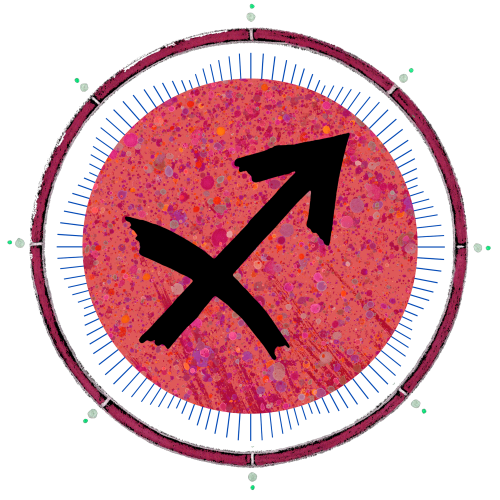Dear Friend and Reader:
While DNA was discovered in the 19th century, it was not until 1953 that James Watson and Francis Crick discovered the double helix configuration that is now recognized as the sigil of life itself.

Between 1938 and 1943, Aleister Crowley (1875-1947) and Lady Frieda Harris (1877-1962) created the Thoth Tarot. It started as a three-month project but took a little longer. The deck was not published until 1969, after its creators were long gone.
Thoth Tarot was a major evolution on the tarot in many ways. One is that it visually keyed the cards to astrological symbols. The cards have always had a connection to astrological symbols, though the whole point of the tarot was to be disguised as a game so that it would not be seen as an esoteric tool. The symbols were encrypted into the designs of the cards, and conveyed through numerology.
One of Crowley’s roles as an author and teacher was to turn the esoteric inside out. As part of that mission, he identified most major and minor arcana cards with astrological glyphs. There was never any doubt among those initiated into the tradition that the 13th card in the major arcana (Atu 13) was associated with Scorpio. But as with many things, he makes it plain.
The Spookiest and Most Complex Sign
Scorpio is one of those things about astrology that spooks people. That is, even those who don’t believe in astrology or give a toss about it might be made nervous by the topic area of Scorpio (all that you cannot discuss at the Thanksgiving dinner table), and also by the witchy power they perceive Scorpios as having.

It’s easy to imagine a thermonuclear physicist, born under the sign Scorpio but who does not vaguely believe in astrology or support the proposition, having a little gleam in his eye when asked his birth sign.
One of the great things about The Book of Thoth is that Crowley teaches astrology throughout it. Though not known as an astrology author, he ghostwrote several books for Evangeline Adams, known as the mother of American astrology. As such, he is its illegitimate father.
When you read Crowley’s interpretation of the Death card in The Book of Thoth (which he published on the vernal equinox of 1944, with the Sun on the Aries Point) you would get the correct impression that Scorpio is the most complex sign of the 12. He considers the symbols of the scorpion, the serpent, the eagle and the fish for this one card. He also brings in symbols from Capricorn, such as the scythe.
Yet one thing shines out: the dancing figure of Death is traveling down a double helix, fully a decade before it was discovered. The spiral trails off into the infinity of the past. The figure of the skeleton is blazing into the present.
The double helix is not merely a decoration or design feature; nothing in the tarot is. It would be less impressive if the nature of Atu 13 and Scorpio were not so closely related to the nature of DNA and how it regulates both life and death.
The card represents transformation: endings, and also birth and the movement through conception into the stages of life, death, decay and rebirth — which is a journey down the double helix. Scorpio is associated with the genitals and therefore with sex and reproduction, the compelling force that is driving the whole process forward.
This is one of many examples of how esoteric scholars were way ahead of science. If you know the history of both, it can become a running joke as you move through your studies. In fact, science itself emerged from the esoteric traditions: astrology became astronomy; alchemy became chemistry; and witchcraft and herbalism became medicine.

The Sex-Death Connection in Genetics
Contemporary genetic theory took a while to catch up with the deeper nature of Scorpio, though one of the most interesting things I’ve learned is that the sex-death connection is scripted into our DNA history two ways, at least. According to the book Sex and the Origins of Death by William R. Clark, the first is that because we reproduce sexually, we must be mortal.
The random shuffling of the genetic code with each reproductive event is associated with mortality. Said another way, immortality or nonrandom reproduction would be associated with asexual reproduction, such as species that reproduce by cloning.
“We die because our cells die,” Clark writes. “Death is the evolutionary consequence of the way we reproduce ourselves.” Remember this when considering whether you like or value sexual expression.
The second is that at about the same time in the lifespan of a person, sexual reproduction and a form of programmed cell death are activated. So in each person, with their secondary sexual characteristics emerging, there commences a genetic body-script involved with mortality. This is more than part of the genetic memory; it is part of the experience of inhabiting a specific unique body. And each of us bears that knowledge from direct experience.
Thanks to sexuality, humans get a spiritual gift, which is the healing and transformative experience of orgasm. Famously called “the little death” in French, orgasm is about letting go into the experience of being alive. As far as I can tell, this physical and distinctly sexual experience would not be possible without sexual reproduction, which is itself the twin experience to death.

Messing with the Genome
I can think of nothing in nature so magnificent as the genome and the way that it contains all of the instructions for life in every cell. For decades, we have experienced an assault on our genetic integrity, through artificial chemical and radioactive onslaughts. While the world tends to freak out about viruses, most of our problems come from “better living through chemistry.” And they come from hundreds of atomic bomb tests, plus disasters and everyday failures at nuclear power plants.
Between October 1990 and April 2003, the government and various other institutions have participated in the sequencing of the total human genome. In its own words, the Human Genome Project “gave us the ability, for the first time, to read nature’s complete genetic blueprint for building a human being.” This has opened a world of trouble.
Though gene splicing and cloning predicated these events by some time, the world entered a new era with the birth of Dolly the Sheep on July 5, 1996, the first cloned mammal. It is probable that humans have also been cloned, which is a frightening prospect.
We are now in a world where gene editing is an industry, including gain of function research on viruses that for years has been conducted and/or sponsored by the National institutes of Health (NIH). This has carried humanity into a new era of hubris: the ability to play God.
It’s more than enough to make any sane person nervous, and concerned about the future. One result has been the creation of genetically modified crops, which can resist application of chemicals like Roundup and Agent Orange that then end up in the food we eat and the air we breathe.

Merging Humans with Computers
The latest development in this is the plan created by Bill Gates to inject people with nanotechnology particles which can then be read by various devices (cell phones, laptops, etc.) and connected to the blockchain as a way to “mine” cryptocurrency. These technologies, if implemented, will be able to read all biometric data, and essentially be able to monitor people from within. Injectable computers could also make people very, very sick.
At the same time, there has been a wider push in recent years and this year in particular to move financial transactions to the blockchain (a massive, next-generation peer-to-peer computer network) and conduct all business through cryptocurrency. This would make people “readable” by 5G technology.
Do we need to consider the dark prospects here? Such as connecting access to one’s bank account and right to travel to one’s vaccine status — read by direct biometrics? Mark Zuckerberg already is selling what he claims is a kind of consumer level mind-reading technology, sold as a virtual reality toy.
Thankfully we are not at the point where “resistance is futile,” but we are very close. We already know there are health and social implications from all technology, and especially “smart” technology, which is bathing us in a constant flood of 3G, 4G, 5G, Wifi, Bluetooth and blue light.
One thing we know about new technologies is that the implications and “unintended” consequences are never considered by the public or regulatory authorities before the advance is accepted and put into use. Further, technologies almost always go out of control, the power they confer on their creators and purveyors is abused, and there are security and privacy issues (to say the least).
The same people who sold your Facebook data and who could not keep your Social Security number private now want to turn you into a device on the Internet of Things.
We might ask why. Do you need this technology, or are you happy to pay for your coffee with a couple of old-fashioned dollar bills or your friendly old debit card?

Scorpio and its Planets: Rare Events
We are currently in a Scorpio moment. At the time of this writing, Mercury is retrograde in Scorpio, and there is about to be a Mercury-Sun conjunction. Mercury will then convey all of its Scorpio power into Libra, where it stations direct on the last day of the U.S. presidential election.
Mars, the classical ruler of Scorpio (that is, Scorpio’s planet back to the dawn of astrology’s origins), is currently retrograde in Aries. In our day we often forget the important connection between Mars and Scorpio, instead using only Pluto (discovered in 1930, only 90 years ago). However, it’s important to honor and check in with the classical rulers, and this is an unusual condition: Mars has not been retrograde in Aries since 1988.
The day before Mars stations direct, Jupiter makes its third conjunction of the year to Pluto, in Capricorn on Nov. 12. This is a year of rare conjunctions — Saturn conjunct Pluto on Jan. 12, 2020, Jupiter conjunct Saturn on Dec. 21, and in between, a series of three Jupiter-Pluto conjunctions. Every conjunction is a new cycle beginning, and here we have three of them turning over at once. Two of these cycles are generational (Jupiter-Saturn and Saturn-Pluto). One happens a couple of times per generation (Jupiter-Pluto). It is however extraordinary to have them all turn over at once.
Without respect to the subject matter of what we are seeing in the world, its rarity is described by the astrology of our time.
Note that while many of these events involve the classical and modern ruling planets of Scorpio, most of the events take place in Aries and Capricorn, which are signs with widescale public impact.
We live in times of profound change, though it is implausible that any of the developments we are seeing are accidents. Even “unintended outcomes” are foreseeable to those who look. However, I know from my McLuhan studies that very few understand the problem, and even fewer care to size it up for what it is.

Pluto in Aquarius
While we are caught in the throes of the U.S. Pluto return, we need to keep track of what is leaning toward Pluto in Aquarius. That is why these nanotechnology injections merging with the blockchain and therefore currency transactions are so disquieting. This is not being designed for our convenience, and make no error, it is being designed — every day, in laboratories, in government offices, and many other places.

We know from long experience that Pluto is about the imposition of power. It is the unstoppable force. Yes, it can represent evolution, though before we get there, it can represent a form of totalitarian control. Aquarius among other things represents technology.
Putting the two together is a caution against the takeover of our lives through technological means. This has already been happening at a disturbing pace. For most, digital began as a video game or iPod and has morphed into a world of surveillance, control and privacy breaches. This very trend is continuing to an exponential degree.
We’re supposed to think this is all just something wonderful being done for our convenience. The past week or so, there has been much discussion in the mainstream media about conspiracy theories. I have been tracking this issue vis a vis Covid for a while. Last week the European Union issued a guidance on the matter. Here is the document.
The wise fathers in what I guess is the Philosophy Section describe as a characteristic of what they term conspiracy theory being the “reinterpreting random events as part of a broader pattern.”
I just find this amusing. How do we know that events are random unless we study the pattern? Are they arguing against use of one of the fundamental gifts of the human mind, which is pattern recognition? And is anything random, particularly with so much energy devoted to planning and design? The very thing we need to do is assess the facts in the context of one another. “Data” is meaningless without some pattern or structure within which to evaluate it.
I can say this for sure. DNA is not random. It is magnificently orchestrated. And the plan to edit and rewrite DNA is not random. It has been developing for well over a century. The plan to weaponize our own DNA against us is not random. It is happening right now. We must take heed.
With love,
![]()
Planet Waves (ISSN 1933-9135) is published each Monday and Thursday evening in Kingston, New York, Planet Waves, Inc. Core Community membership: $197/year. Editor & Publisher: Eric F. Coppolino. Web Developer: Anatoly Ryzhenko. News Editor: Spencer Stevens. Assistant Editor: Anna K. Ball, Joshua Halinen. Client Services: Amy Elliott and Victoria Emory. Illustrator: Lanvi Nguyen. Senior Finance Minister, First Cavalry of the Local Economy: Andrew Slater. Archivist: Morgan Francis. Video Editor: Cate Ryzhenko. Proofreading: Jessica Keet. Media Consultant: Andrew McLuhan. Music Director: Daniel Sternstein. Bass and Drums: Daniel Grimsland. Additional Music: Zeljko. Additional Research, Writing and Opinions: Rachel Chaput, Loreen Costa, Robin Dann, Yuko Katori, Kirsti Melto, Cindy Tice Ragusa, Abby Rohrer, and Carol van Strum.



